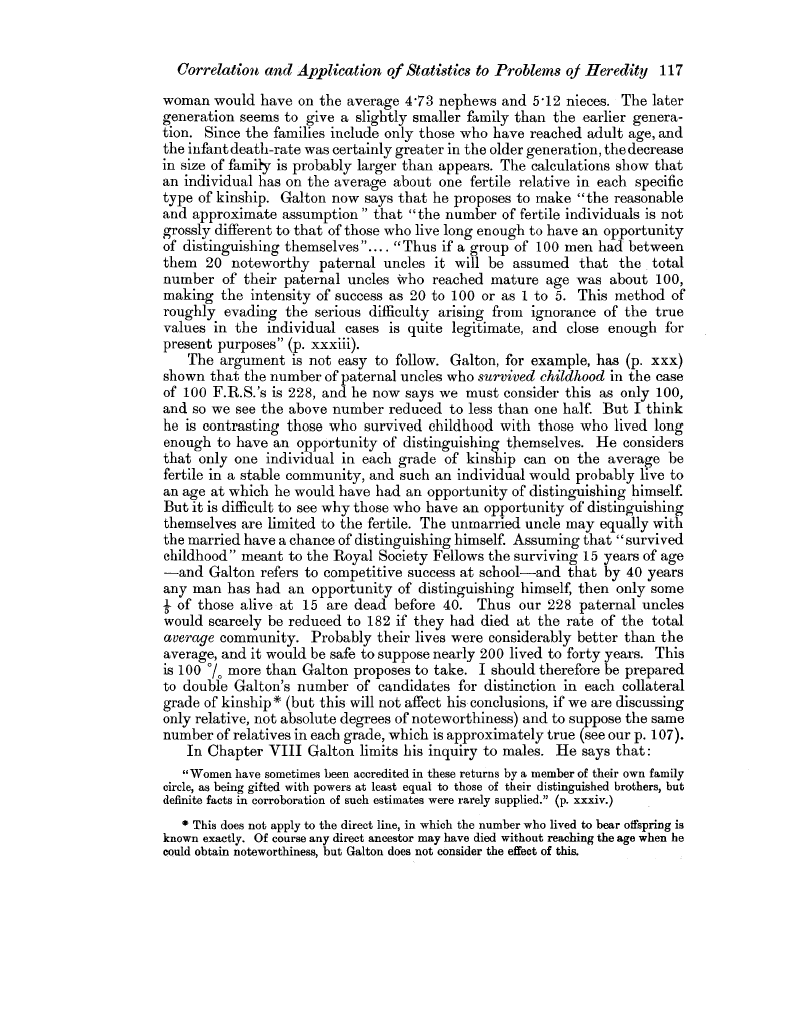| ||||||

OCR Rendition - approximate
Correlation and Application of Statistics to Problems of Heredity 117 woman would have on the average 4.73 nephews and 5.12 nieces. The later generation seems to give a slightly smaller family than the earlier generation. Since the families include only those who have reached adult age, and the infant death-rate was certainly greater in the older generation, the decrease in size of family is probably larger than appears. The calculations show that an individual has on the average about one fertile relative in each specific type of kinship. Galton now says that he proposes to make "the reasonable and approximate assumption" that "the number of fertile individuals is not grossly different to that of those who live long enough to have an opportunity of distinguishing themselves".... "Thus if a group of 100 men had between them 20 noteworthy paternal uncles it will be assumed that the total number of their paternal uncles who reached mature age was about 100, making the intensity of success as 20 to 100 or as I to 5. This method of roughly evading the serious difficulty arising from ignorance of the true values in the individual cases is quite legitimate, and close enough for present purposes" (p. xxxiii). The argument is not easy to follow. Galton, for example, has (p. xxx) shown that the number of paternal uncles who survived childhood in the case of 100 F.R.S.'s is 228, and he now says we must consider this as only 100, and so we see the above number reduced to less than one half. But I think he is contrasting those who survived childhood with those who lived long enough to have an opportunity of distinguishing themselves. He considers that only one individual in each grade of kinship can on the average be fertile in a stable community, and such an individual would probably live to an age at which he would have had an opportunity of distinguishing himself. But it is difficult to see why those who have an opportunity of distinguishing themselves are limited to the fertile. The unmarried uncle may equally with the married have a chance of distinguishing himself. Assuming that "survived childhood" meant to the Royal Society Fellows the surviving 15 years of age -and Galton refers to competitive success at school-and that by 40 years any man has had an opportunity of distinguishing himself, then only some 5 of those alive at 15 are dead before 40. Thus our 228 paternal uncles would scarcely be reduced to 182 if they had died at the rate of the total average community. Probably their lives were considerably better than the average, and it would be safe to suppose nearly 200 lived to forty years. This is 100 °/o more than Galton proposes to take. I should therefore be prepared to double Galton's number of candidates for distinction in each collateral grade of kinship* (but this will not affect his conclusions, if we are discussing only relative, not absolute degrees of noteworthiness) and to suppose the same number of relatives in each grade, which is approximately true (see our p. 107). In Chapter VIII Galton limits his inquiry to males. He says that: "Women have sometimes been accredited in these returns by a member of their own family circle, as being gifted with powers at least equal to those of their distinguished brothers, but definite facts in corroboration of such estimates were rarely supplied." (p. xxxiv.) * This does not apply to the direct line, in which the number who lived to bear offspring is known exactly. Of course any direct ancestor may have died without reaching the age when he could obtain noteworthiness, but Galton does not consider the effect of this.
|